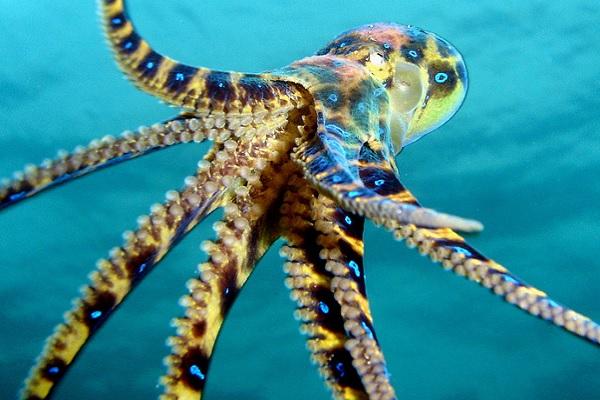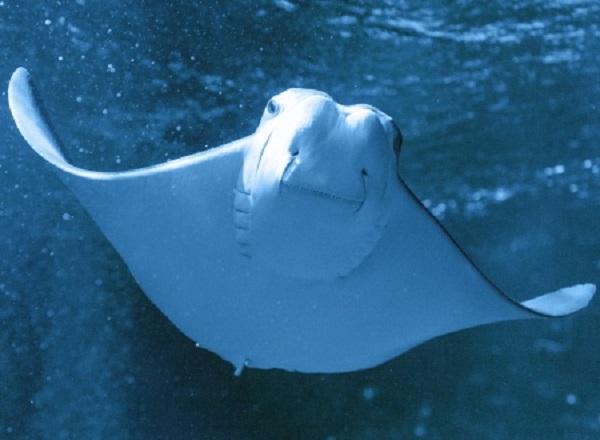Каким бы безмятежным и привлекательным ни казалось дно океана, вы должны помнить, что эта среда также очень опасна, некоторые из самых смертоносных существ в мире могут быть найдены в море или на дне наших океанов. Удивительно, но не все из них соответствуют вашим ожиданиям по размеру, некоторые из самых смертоносных морских животных в мире могут быть размером с бейсбольный мяч, а такие животные, как тигровые акулы, могут достигать 5 метров в длину. Вот взгляд на самых смертоносных морских существ, живущих в воде. Этот список субъективен, но мы потратили время на то, чтобы провести здесь исследование, чтобы выяснить, какие существа с глубоководного дна океана вызывают у людей наиболее убедительную комбинацию агрессии, страха, настоящей боли или даже смерти…
Морская змея
Даже будучи включенным в число наземных видов, морская змея по-прежнему остается самой ядовитой змеей на планете. Количество яда, которое может ввести морская змея, достаточно, чтобы сделать королевскую кобру безобидным дождевым червем, всего несколько миллиграммов ее яда достаточно сильны, чтобы убить до тысячи человек! Морская змея, также известная как гидрофонная или коралловая рифовая змея, представляет собой подсемейство ядовитых неуклюжих змей. Хотя они произошли от наземных предков, большинство из них приспособлены к водной жизни и не могут передвигаться по суше. Они обычно встречаются в водах Юго-Восточной Азии и Северной Австралии.

Мраморная конусная улитка
Ярко окрашенная раковина улитки-мраморного конуса соблазняет людей взять ее в руки, не зная, что это животное является одним из самых ядовитых морских существ в мире. Мраморную конусную улитку можно найти в водах Окинавы, южной оконечности Индии и юго-восточной части Новой Каледонии и Самоа. Улитка с мраморным конусом использует свой гарпунообразный хоботок, чтобы поразить свою добычу и потенциальных хищников смертельной смесью нейротоксинов.
Он использует свой смертоносный гарпун, чтобы парализовать свою добычу , пожирая ее на досуге. Укус одной из этих улиток-конусов может оказаться смертельным, так как яд вызывает мышечный паралич и дыхательную недостаточность. Противоядия от укусов конусных улиток в настоящее время не существует. Вместо этого можно применять различные методы лечения, пока действие токсина не пройдет. Так что в следующий раз, когда вы увидите эту красивую ракушку на пляже, обязательно держитесь подальше.
Каменная рыба
Каменная рыба действительно должна быть одной из самых уродливых рыб, которых я когда-либо видел, она не нападает на вас, но вы не хотите просто наступить на нее, обычно она встречается на мелководье в тропиках и распространяется по всему Тихому океану. и Индийский океан, Красное море и большой барьерный риф, он выглядит непривлекательно с кожей, похожей на скалу. По сути, его яд вызывает сильную боль и иногда может вызвать шок, паралич, отмирание тканей и смерть, если его не лечить, он также может привести к другим осложнениям, если лечение не будет предложено быстро, и его боль настолько мучительна, что жертва может оказаться в опасности. просить об ампутации пораженной конечности.
Соленый водный крокодил
Морской крокодил встречается на восточном побережье Индии, Юго-Восточной Азии, простирающейся на юг до северной Австралии и восточного побережья Африки. Морской крокодил — грозный и легко приспосабливающийся хищник, способный схватить практически любое животное, которое войдет на его территорию. Это хищник из засады, выжидающий удобного случая для удара. Его зубы предназначены не для того, чтобы разрывать плоть, а для того, чтобы удерживать добычу, что снижает шансы животного на побег. Эти свойства позволяют крокодилу поймать и утащить животное в воду, после чего добыча проглатывается целиком или разрывается на части. Морской крокодил считается самым опасным видом крокодилов для человека.

Синекольчатый осьминог
Имея не более 8 дюймов в длину, синекольчатый осьминог наделен достаточным количеством яда, чтобы убить человека — на самом деле, у них достаточно яда, чтобы убить почти 30 человек всего за несколько минут. Они признаны одними из самых ядовитых морских существ в мире. Несмотря на то, что они такие маленькие по размеру и относительно послушные по своей природе, их яд в 10 000 мощнее цианида . Желчь синекольчатого осьминога приведет к параличу, а если лекарство не будет введено сразу, это обязательно приведет к смерти. Вас также может шокировать тот факт, что сам укус безболезненный, а это означает, что вы можете даже не осознавать, что вам сделали инъекцию, пока не почувствуете симптомы. Поскольку синекольчатый осьминог кусает только в том случае, если его спровоцировать, держаться на расстоянии — лучшее лечение из всех, тем более что для этого смертоносного морского существа вообще нет противоядия.
Коробка мармеладок
Кубомедуза (также известная как морская оса) — очень опасное существо, обитающее в северо-восточных районах Австралии. У медузы есть экстремальные 60 минут на щупальцах, которые при контакте с человеком могут остановить сердечно-дыхательную функцию в течение трех минут. По данным Национального фонда США, только на Филиппинах ежегодно от укусов кубомедузы умирает от 20 до 40 человек. У кубомедузы достаточно яда, чтобы убить 60 взрослых людей в кратчайшие сроки. Его яд поражает сердце, нервную систему и клетки кожи, поэтому он считается одним из самых смертоносных в мире. Это настолько невыносимо болезненно, что люди, как известно, впадают в шок и тонут или умирают от сердечной недостаточности, даже не достигнув берега.

Морской лев
Для морских львов характерны наружные ушные раковины, длинные передние ласты, способность ходить на четвереньках и короткая густая шерсть. Они поддаются дрессировке и являются главной достопримечательностью зоопарков, но, как известно, кусают людей. Морские львы обычно игривы; однако они могут быть территориальными и опасными, особенно в брачный период. Поскольку они поддаются дрессировке, они также могут нападать на людей. Некоторые местные ученые говорят, что поведение морских львов непредсказуемо и может внезапно стать агрессивным.
Рыба фугу
Рыба фугу содержит токсин, смертельный для человека. В одной рыбе фугу содержится достаточно токсина, чтобы убить 30 человек, и противоядия не существует. По иронии судьбы, эта рыба считается деликатесом в Японии, несмотря на то, что один плохой порез означает верную смерть.
Рыба фугу содержит яд, смертельный для человека. Этот смертельный яд, называемый тетродотоксином (ТТХ), содержится в этой жирной рыбе. Этот токсин считается более мощным, чем цианид, и его достаточно, чтобы убить 30 человек за раз. Это приводит к затруднению дыхания у человека, прежде чем привести к смерти.
Сом
Удивлен? Да, они кажутся очень невинными, выглядят очень безобидными и миролюбивыми с их маленькими и милыми усами. С другой стороны, они могут быть очень опасны, особенно если их спровоцировать. Сом реагирует на угрозу, он делает это, выдергивая из спинного и боковых плавников три своих колючих шипа. Вам также может быть интересно узнать, что его яд может оставаться активным даже после смерти.

Морской скат
Каким бы смертоносным ни был скат, он атакует только в целях самообороны, возможно, когда на него случайно наступают. Чтобы атаковать, он должен находиться прямо напротив своей жертвы, чтобы иметь возможность щелкнуть своим длинным хвостом сзади, а затем ударить свою жертву спереди. Механизм заключается в том, что скат ударяет хвостом, и сила, с которой хвост жала входит в тело жертвы, вызывает разрыв его защитного листа, поэтому яд вытекает в рану жертвы. Но на этом дело не заканчивается, поскольку яд смертелен, вытаскивание его жала из тела жертвы может быть очень грубым, достаточно грубым, чтобы вызвать смерть.
📚 Не пропустите интересную информацию:
-
Животные которые умеют считать: удивительные математические способности в дикой природе
Многие люди считают, что математика — исключительно человеческая наука. Однако исследования последних десятилетий показывают, что животные которые умеют считать встречаются гораздо чаще, чем мы думали.... -
7 животных, которые вдохновляют ученых и формируют будущие технологии
Как вы думаете, природа — настоящий изобретатель? Конечно, так и есть! А что, если бы мы сказали вам, что сверхспособности, которые мы видим в научно-фантастических... -
10 прозрачных животных, которых вам будет трудно увидеть из-за их прозрачных структур
Иногда в природе встречаются такие существа, увидеть которых практически невозможно! Прозрачные животные, замаскированные как секретные агенты, буквально сливаются с окружающей средой благодаря своим прозрачным структурам.... -
2026 год кого? Животное по восточному календарю
Год кого по восточному календарю, ждет нас в 2026 году, ведь так важно знать, что готовит нам вселенная. С 17 февраля 2026 года по 5... -
10 странных яиц животных, которые вас удивят, когда вы их увидите
Природа подобна театральной сцене, полной сюрпризов. В этом театре есть такие актеры, что невозможно не удивляться, глядя на яйца, которые они производят. Невеста спросила: «Что...







